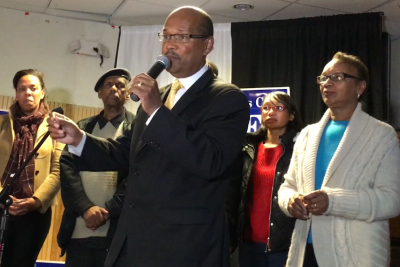December 30, 2015
 Savin Hill Beach, Feb. 15, 2015
Savin Hill Beach, Feb. 15, 2015
Shifting winds were the order of the day in Boston 2015, not in the least due to a historic winter that left the city – and the T – buried in snow and ice. Beginning with the ultimately doomed effort to bring the 2024 Summer Olympics to the region, with Dorchester playing a leading role, and ending with the ouster of the two most senior city councillors, the year was one of stormy times and sunny stretches.
Operation Olympics: Up and Down Affair
With the new year came the start of a rollercoaster ride when the US Olympic Committee announced that Boston was its choice to compete on behalf of the US for the 2024 Summer Olympics. Early on, The Reporter pursued questions of funding for Dorchester components of the bid, noting a week after the announcement – and in the face of a contrary claim by Olympics backers – that no money had been earmarked for costly Kosciuszko Circle improvements and the rehab of the JFK/UMass MBTA Station rehab.
Communication by proponents with landowners and businesses was an issue almost immediately. On Columbia Point, key stakeholders expressed bewilderment in late January at not having been contacted by Boston 2024 Organizers regarding the construction on the Point of the 170-acre Athletes Village. This consternation flew in the face of assertions by Olympics boosters that all owners had been brought to the table regarding the use of, and access to, the land. The Reporter also found that business owners in Widett Circle, site of the proposed “Midtown” development, felt shut out of the process.
.png) Boston 2024 rendering showed proposed Olympic Village on Bayside site
Boston 2024 rendering showed proposed Olympic Village on Bayside site
Complaints of a lack of transparency were both loud and widespread as calls for documentation about various proposals were met with resistance. Early bid documents were released with funding plans redacted, and when the the full text of the initial bid was finally released, the updated proposal – dubbed “Bid 2.0” – had already been rolled out.
Strong public opposition to the bid built during the brutal winter, some of it in connection with the MBTA’s struggle with the six-week onslaught of crippling storms. Seeing the daily chaos, critics began asking about the transit authority’s ability to pay and plan for a huge event like the Olympics games.
On July 27, almost seven months after the selection of Boston, Mayor Martin Walsh struck the fatal blow, announcing that he would not put taxpayers on the hook for any potential cost over-runs. Shortly thereafter, the Olympic Committee withdrew its support of Boston and turned to Los Angeles as its alternate candidate to host the games in 2024.
The financial concerns expressed by Walsh and others were well founded, according to a post-mortem report sought by the state and released by the consulting firm Brattle Group. The report asserted that the “biggest sources of risks” were efforts to secure private developers. Relying upon that model to fund construction, including the Athlete’s Village, could have been viable, the report noted, but the financial risk to the public with even slight complications to the plan would be substantial.
Winter Wouldn’t Let Us Up
Lulled by a quiet November, December, and early January, the region was thinking spring might come early in 2015. But the hammer came down late in the third week of January when a nine-inch snowfall initiated a parade of storms, several of the blizzard variety, that lasted until mid-March and left the region with its transportation systems in chaos and Boston with the biggest-ever snowfall levels as recorded by the National Weather Service – 110.6 inches.
Close to home, the Mattapan trolley took it hard. With shuttles replacing trolley service for weeks at a time, Mattapan business owners told the Reporter the disruptions were costing them tens of thousands of dollars in revenue from fewer patrons making their way to Mattapan Square. And gridlock virtually defined Dorchester Avenue and its off-street arteries during the stormy onslaught; the streets were minefields of potholes, frozen puddles, slippery streets, and high, soot-dark snow banks.
 Charles Yancey defeated
Charles Yancey defeated
Change Comes To the Council
Charles C. Yancey had held his District 4 city council seat since its creation in 1983. Combined, he and at-large Councillor Stephen Murphy boasted a collective 50 years of council experience, all of which came to an end in November when both were ousted by younger challengers.
A political newcomer, 33-year-old Andrea Campbell, ran a well-financed and energetic campaign for change against Yancey, the 66-year-old incumbent. She scored a solid victory in the preliminary election, earning 58 percent of the vote to Yancey’s 34 percent in a municipal preliminary that featured an embarrassing 7.07 percent turnout.
Campbell kept that margin in the general election, winning 61.32 percent of the vote to Yancey’s 38.42 percent. While Campbell’s supporters celebrated, Yancey thanked his team and his family while citing his decades of achievements, chiefly the two community centers, a police station, and a hugely popular book fair that he boosted for his community. His dream of a high school in Mattapan remains unrealized.
Dorchester native and Hyde Park resident Murphy lost his hold on his at-large slot to Annissa Essaibi-George, a Polish Triangle resident and owner of the Stitch House on Dorchester Avenue. She improved on her fifth-place showing in 2013, gathering 17.86 percent of the vote to Murphy’s 14.86 percent to take the fourth at-large seat.
The departing councillors were sent off in a tearful farewell in mid-December. Campbell and Essaibi-George will be sworn in next Monday, Jan. 4.
Housing Market In the Spotlight
Along with the rest of the city, Dorchester real estate has been soaring over the past few years. A report by the Boston Foundation in November found a meager occupancy rate and a city overwhelmed by prohibitive construction and labor costs.
Prices for Boston’s classic three-deckers have risen 95 percent since 2009, and 8 percent since last year, up to $477,057 by the end of 2015. But in Dorchester, which consistently tops the list of three-decker sales, selling has declined, with the lowest number of purchases since 2010 expected this year.
Affordable housing is increasingly a concern in this market. The city has updated its Inclusionary Development Policy in early December by adjusting its approach to city regions, breaking them into three zones along existing neighborhood boundaries and reflecting significant differences in rents and housing values.
An area of concern for advocates addressed a component to the IDP in Zone C, which includes Dorchester, Roxbury, Mattapan, Hyde Park, and West Roxbury. While all affordable housing rates are held at 70 percent of Area Median Income (AMI), some exceptions could be made in Zone C to raise that up to 100 AMI. The city asserts that the option would only be considered when construction would otherwise be infeasible. Still, fair housing advocates worry that the policy will unduly hamper those who need to apply Section 8 vouchers toward their rents.
Civics Focusing on Development
Neighborhood associations in Dorchester have been giving a hard look to new development as its edges into the area. New businesses such as the proposed Sam Maverick’s eatery at Adams Corner have faced some pushback from abutters and neighborhood groups.
In cases such as 73-77 Dix St. and 364-366 Neponset Ave, civic groups have vehemently opposed construction they say is out of character with the neighborhood and in violation of the zoning code. The Neponset Avenue property got the go-ahead despite objections, and the Pope’s Hill Neighborhood Association called for the Walsh administration to clarify its position on civic input into the approval process.
A project long in the making, and largely okayed by the Columbia-Savin Hill Civic Association, the DOT Block mixed-use project at Glover’s Corner has revamped its design as three corner properties left the developer’s control. Now, issues surrounding retail raise the possibility of another redesign, though the team asserted in late November that development remains mostly on schedule for a spring groundbreaking.
Columbia-Savin Hill has worked throughout the year on standards for its approach to new development. The association released a list of guidelines late in 2015 that it presented to city and state officials. Other civic groups are assessing the report for its usefulness for their purposes.


